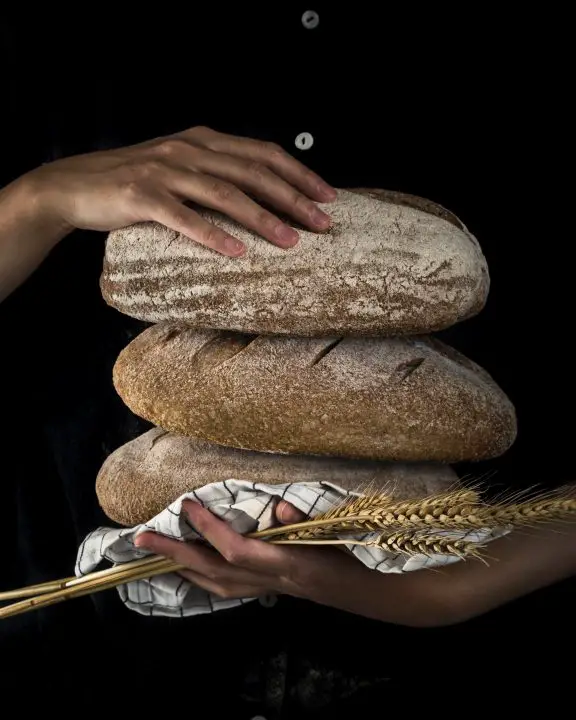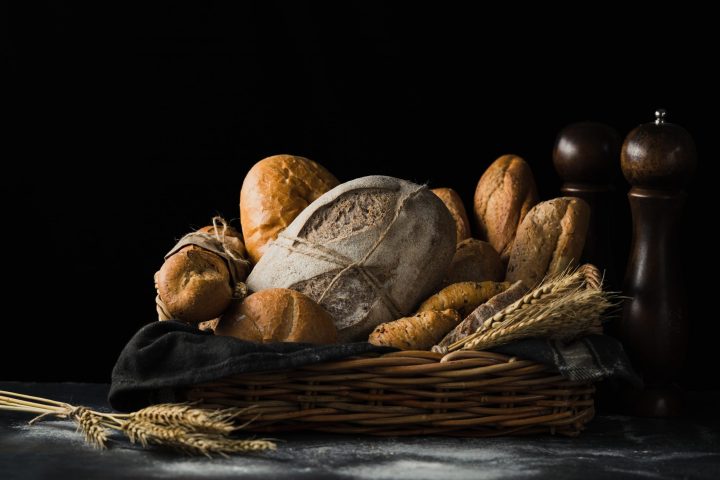You may have heard many praise the magnificence of whole wheat bread, with many opting for it because it is considered a “healthier” option. But with the rising popularity of sourdough bread, many may be wondering whether sourdough bread is considered a whole grain. Depending on the type of diet you’re following, you may find yourself gravitating towards the more tangy and flavorful bread that is sourdough. So let’s discover just how healthy sourdough is.
Table of Contents
- What is Whole Grain?
- Benefits of Sourdough Bread
- Sourdough vs Whole Wheat Bread
- Is Sourdough Whole Grain?
- Is Sourdough Bread Healthy?
- Is Whole Wheat Bread Healthy?
- Types of Healthy Bread
- Healthy Sourdough Whole Grain Recipes
- So is Sourdough Bread Whole Grain?
- FAQs
What is Whole Grain?
Whole grains are found in many foods, such as bread, pasta, cereal, crackers, tortillas and more. They are also a common ingredient in many foods such as pancakes, waffles, muffins, bagels and more.
Whole grains are easily added to recipes to add extra nutrition or used as substitutes for refined grains, and if you want to reduce the amount of refined carbohydrates you eat.
Benefits of Sourdough Bread
Sourdough is a fermented food. During fermentation, yeast and bacteria break down phytic acid, a compound that can block the absorption of some minerals, such as iron and zinc.
Phytic acid is found in grains and beans – two of the most common ingredients in bread. So if you’re following a gluten-free diet, or simply prefer to avoid eating wheat, sourdough may be healthier for you than other types of breads ( I explore sourdough being gluten free or not on my blog).
One of the biggest advantages of sourdough is that it contains fewer calories than regular bread. A slice of sourdough has about 110 calories, while a slice of white bread can have up to 150. Sourdough also has less fat and more protein than white bread.
Additionally, sourdough is higher in vitamins and minerals compared to regular wheat-based products. The fermentation process increases the nutrients available to your body by breaking down much of the fiber and starch into simple sugars that are easier for your body to digest.
Sourdough vs Whole Wheat Bread
When assessing the difference between sourdough bread and whole wheat bread, then it’s worth mentioning that the fiber content of sourdough is higher than that of white or regular sandwich bread. This means that it helps promote digestion and lower cholesterol levels. As well as helping you feel full longer because it takes longer to digest than sugary foods like cakes or cookies, so you’ll be less likely to snack on junk food later on!
However, whole wheat bread has more protein than sourdough or traditional white breads. Because it’s made from whole grain flours, there’s plenty of protein in this variety of bread to help nourish your body after a hard productive day.
Whole grain foods like whole wheat contain more nutrients than refined grains like white flour. On the other hand, some people feel that sourdough contains helpful bacteria that can aid digestion or even help prevent cancer or other diseases.
Whole wheat bread and sourdough bread are both good sources of fiber, vitamin E and magnesium. In addition, they both provide some B vitamins and iron.
Is Sourdough Whole Grain?
Yes, sourdough bread can be made with whole grains, making it that much more healthy than other breads. As mentioned, whole grains are a good source of fiber and many vitamins and minerals, such as magnesium, zinc, iron and selenium. They also help to keep you feeling full for longer.
You can find whole grain sourdough bread in many forms. The most common form and shape is the round loaf, which comes in many sizes. The size of the loaf depends on how big you want it to be. You can also get sourdough rolls or bagels, or even a sourdough pizza crust!
There are also some brands that sell just flavored varieties of their regular white or rye loaves with some added whole grain content.
Is Sourdough Bread Healthy?
Sourdough is packed with health benefits.
Sourdough bread contains more protein than most other types of bread. And, like all whole grains, sourdough is a great source of fiber. Meaning that you can enjoy your sourdough bread in abundance, knowing that it will only benefit your body!
Regular bread is made with commercial yeast, which releases carbon dioxide gas to make the dough rise as it ferments. Whereas sourdough uses naturally occurring bacteria and yeasts instead of commercial yeast, which causes the dough to ferment over a longer period of time.
Is Whole Wheat Bread Healthy?
Whole grains contain fiber and protein, which are helpful nutrients. Fiber helps keep you full longer, while protein can help build muscle. However, whole wheat bread is not the only source of these important nutrients. Other foods such as fruits and vegetables also contain both fibres and proteins, so if you want to get your fill of both without relying on whole wheat bread alone, it’s best to diversify your diet.
Whole wheat bread is not necessarily any healthier than white bread (or other breads). Whole grain contains fiber and protein. It also contains a number of other nutrients, including magnesium and selenium.
Whole grain foods are more calorically dense compared to refined grains and processed foods, so it’s important to consider what you are eating in addition to the number of calories you consume each day.
For instance, if you choose to eat three slices of whole wheat bread with butter at lunchtime instead of two slices of white toast with jam on it for breakfast, your total calorie intake will be different but may not provide additional health benefits.
If you’re not careful, the extra calories from the husk and bran of wheat can contribute to weight gain, especially if you’re not following a balanced diet. Whole grain foods like whole wheat bread are better than refined grains, but they still contain more calories than white bread.

Types of Healthy Bread
If you’re looking for a healthier bread that won’t make you feel guilty, then try these types of bread. They’re much more nutritious than white bread, and they contain fiber and other nutrients.
- Ezekiel Bread
- Rye Bread
- Sourdough Bread
- Whole Wheat Bread
- Sprouted Grains Bread
Ezekiel Bread
Ezekiel bread is an excellent choice for people with high cholesterol or allergies to gluten, as it contains no sugar and is made from sprouted grains. It’s also high in fiber, protein, vitamins and minerals. Ezekiel bread contains more antioxidants than other breads because of its whole grain ingredients.
Rye Bread
Rye bread is a whole grain, meaning that the entire grain kernel is used. It’s also high in fiber, protein, iron and magnesium—in fact, rye contains more selenium than any other type of wheat. In addition to these nutrients, it has Vitamins B, zinc, and manganese. The best way to eat this healthy bread may be as an open-faced sandwich on top of a salad or bowl of soup!
Sourdough Bread
Sourdough bread has more nutrients than regular bread because it doesn’t use any kind of added sugar or preservatives in its preparation. It also tends to be more digestible than regular yeast-based breads due to their increased levels of lactic acid bacteria, which aid in digestion by breaking down food into smaller particles.
This can help reduce bloating or other digestive issues that come with eating too much processed wheat products like white flour or refined sugars like brown sugar or honey which can cause problems when they’re broken down at different rates contrary to whole grains.
Sourdough bread has also been the preferred bread of many for weight loss.
Whole Wheat Bread
A whole wheat bread is made from 100% whole wheat flour, so it has all the nutritional benefits of a whole grain. Whole wheat breads can be consumed any time of day, whether its for breakfast with peanut butter, as a mid-morning snack, on their own, or with a delicious fruit spread. You can have it as part of lunch or dinner, along with soup or salad. Or perhaps you’d prefer to have it after dinner to satisfy that late evening craving for something sweet!
You can enjoy them in many ways: toast them in the oven before spreading jam on top, make sandwiches filled with meats and cheeses or nut butters such as peanut butter or cashew butter.
Sprouted Grains Bread
While sprouted grains are a bit more expensive than regular bread, they’re also more nutritious and easier to digest. Sprouting helps break down the starch in whole grains so that it’s easier for your body to absorb the nutrients.
And because there are fewer antinutrients in sprouted grain breads, you may find that you feel less bloated after eating them. Sprouted grains also have a higher content of vitamins and minerals than their non-sprouted counterparts, which means they’re an especially good choice if you’re trying to boost your intake of vitamins and minerals without resorting to supplements or fortified foods like cereal.

Healthy Sourdough Whole Grain Recipes
To make healthier choices when it comes to enjoying the plush, cushioned whole grain bread, begin with a good starter, and then shape it into anything you like!
Perhaps a sourdough pizza sounds particularly tantalising, or sourdough crackers dipped in some hummus. Delicious and healthier alternatives like these will have you feeling more confident whenever you reach for a piece of sourdough pizza or sandwich. Your sourdough starter is the perfect vessel in creating a variety of irresistible treats. Here are some for you to try:
- Sourdough Pizza
- Sourdough Waffles
- Sourdough Donuts
- Sourdough Crackers
- Sourdough Sandwich
Sourdough Pizza
Sourdough pizza dough is a healthy alternative to regular pizza dough. It takes only a few minutes to make. It’s also easy enough that even kids can help out in the kitchen!
- Start by mixing together 1 cup of sourdough starter, 1 tablespoon olive oil, 1 cup warm water and 2 cups flour until you have a smooth ball of dough.
- Let the dough rest for 15-20 minutes while your oven preheats to 425 °F.
- Roll out your pizza crust onto an oiled baking sheet or peel topped with cornmeal.
- Top with sauce, cheese, vegetables and meat toppings of choice.
- Bake for 10–15 minutes until golden brown on top.

Sourdough Waffles
These sourdough waffles, are the perfect type of hefty breakfast to start the day. Not to mention they’re incredibly delicious!
- In a large bowl, whisk together the sourdough starter with eggs, milk and vanilla extract.
- Add flour, sugar, baking powder, salt and mix until well combined – bearing in mind that the mixture will be very thick.
- Melt butter in a skillet on medium heat until it begins to brown slightly – this will add flavor to your waffles!
- Pour 1/2 cup batter into each section of your waffle iron and cook for approximately 3 minutes per side.
- These freeze well so you can make them ahead of time if needed!
Sourdough Donuts
Sourdough donuts are a healthier alternative to the regular donuts you find at the grocery store. They are made with whole grains, have no added sugar and are not fried. Moreover, they are gluten free, vegan and dairy free! Check out this irresistible sourdough donut recipe.
Sourdough Crackers
Sourdough crackers are the lighter, and crisp version of regular crackers. Simply dip these crunchy little snacks into some healthy hummus and you’re good to go!
Sourdough Sandwich
You can use your sourdough starter to make this sandwich bread. But make sure it is active and ready to be used. If you have a new starter, feed it at least one day before making this sourdough sandwich recipe.
So is Sourdough Bread Whole Grain?
Sourdough bread can be made with any type of flour, specifically whole grains if you wish, depending on what you add initially, to make your starter.
Did you know you can make whole wheat sourdough? Check it out!
FAQs
Is Sourdough Bread Considered Whole Grain?
Although sourdough bread can be made from many different types of flour, it is usually made from whole grain.
Is Sourdough Healthier than Whole Grain?
When using whole grains to make sourdough bread, then sourdough is considered healthy. Additionally, sourdough bread is deemed healthier than regular bread.
What Grain is Sourdough made from?
The main ingredient in sourdough bread, is normally wheat flour, which contains gluten.
Is Sourdough Healthier than Multigrain Bread?
Both loaves contain 80 calories, with sourdough being a little more tempting on the tongue, however multigrain bread delivers double the fibre than sourdough.




![What Soup Goes Well With Sourdough Bread [15 Best Soups To Try] 7 What soup goes well with sourdough bread [15 best soups to try]](https://www.mydailysourdoughbread.com/wp-content/uploads/2023/06/soups-with-sourdough-120x120.jpg)

